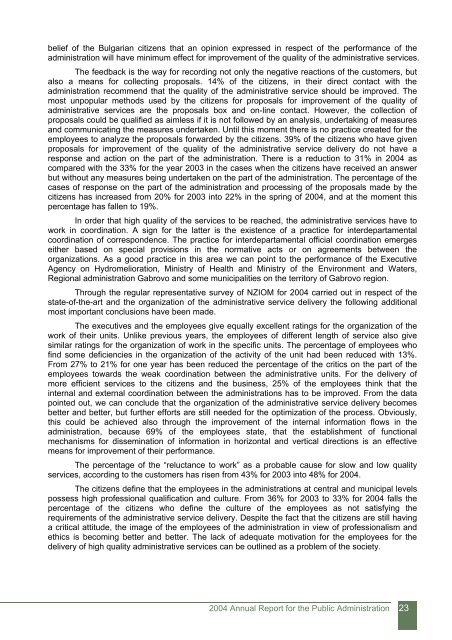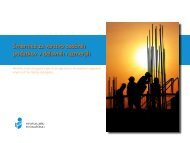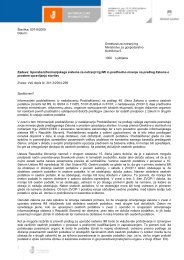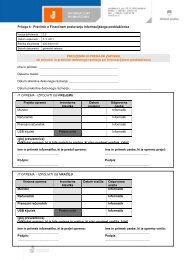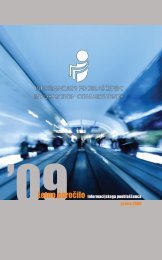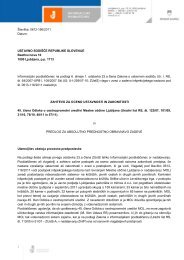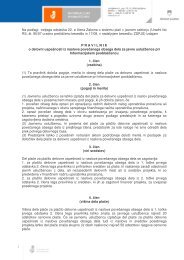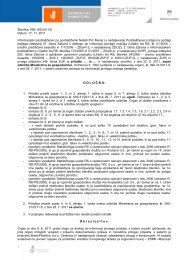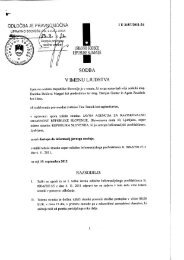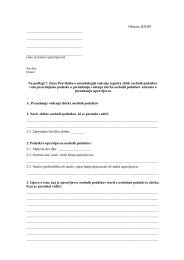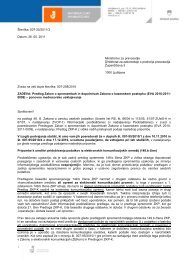Annual Report for the Public Administration 2004
Annual Report for the Public Administration 2004
Annual Report for the Public Administration 2004
You also want an ePaper? Increase the reach of your titles
YUMPU automatically turns print PDFs into web optimized ePapers that Google loves.
elief of <strong>the</strong> Bulgarian citizens that an opinion expressed in respect of <strong>the</strong> per<strong>for</strong>mance of <strong>the</strong><br />
administration will have minimum effect <strong>for</strong> improvement of <strong>the</strong> quality of <strong>the</strong> administrative services.<br />
The feedback is <strong>the</strong> way <strong>for</strong> recording not only <strong>the</strong> negative reactions of <strong>the</strong> customers, but<br />
also a means <strong>for</strong> collecting proposals. 14% of <strong>the</strong> citizens, in <strong>the</strong>ir direct contact with <strong>the</strong><br />
administration recommend that <strong>the</strong> quality of <strong>the</strong> administrative service should be improved. The<br />
most unpopular methods used by <strong>the</strong> citizens <strong>for</strong> proposals <strong>for</strong> improvement of <strong>the</strong> quality of<br />
administrative services are <strong>the</strong> proposals box and on-line contact. However, <strong>the</strong> collection of<br />
proposals could be qualified as aimless if it is not followed by an analysis, undertaking of measures<br />
and communicating <strong>the</strong> measures undertaken. Until this moment <strong>the</strong>re is no practice created <strong>for</strong> <strong>the</strong><br />
employees to analyze <strong>the</strong> proposals <strong>for</strong>warded by <strong>the</strong> citizens. 39% of <strong>the</strong> citizens who have given<br />
proposals <strong>for</strong> improvement of <strong>the</strong> quality of <strong>the</strong> administrative service delivery do not have a<br />
response and action on <strong>the</strong> part of <strong>the</strong> administration. There is a reduction to 31% in <strong>2004</strong> as<br />
compared with <strong>the</strong> 33% <strong>for</strong> <strong>the</strong> year 2003 in <strong>the</strong> cases when <strong>the</strong> citizens have received an answer<br />
but without any measures being undertaken on <strong>the</strong> part of <strong>the</strong> administration. The percentage of <strong>the</strong><br />
cases of response on <strong>the</strong> part of <strong>the</strong> administration and processing of <strong>the</strong> proposals made by <strong>the</strong><br />
citizens has increased from 20% <strong>for</strong> 2003 into 22% in <strong>the</strong> spring of <strong>2004</strong>, and at <strong>the</strong> moment this<br />
percentage has fallen to 19%.<br />
In order that high quality of <strong>the</strong> services to be reached, <strong>the</strong> administrative services have to<br />
work in coordination. A sign <strong>for</strong> <strong>the</strong> latter is <strong>the</strong> existence of a practice <strong>for</strong> interdepartamental<br />
coordination of correspondence. The practice <strong>for</strong> interdepartamental official coordination emerges<br />
ei<strong>the</strong>r based on special provisions in <strong>the</strong> normative acts or on agreements between <strong>the</strong><br />
organizations. As a good practice in this area we can point to <strong>the</strong> per<strong>for</strong>mance of <strong>the</strong> Executive<br />
Agency on Hydromelioration, Ministry of Health and Ministry of <strong>the</strong> Environment and Waters,<br />
Regional administration Gabrovo and some municipalities on <strong>the</strong> territory of Gabrovo region.<br />
Through <strong>the</strong> regular representative survey of NZIOM <strong>for</strong> <strong>2004</strong> carried out in respect of <strong>the</strong><br />
state-of-<strong>the</strong>-art and <strong>the</strong> organization of <strong>the</strong> administrative service delivery <strong>the</strong> following additional<br />
most important conclusions have been made.<br />
The executives and <strong>the</strong> employees give equally excellent ratings <strong>for</strong> <strong>the</strong> organization of <strong>the</strong><br />
work of <strong>the</strong>ir units. Unlike previous years, <strong>the</strong> employees of different length of service also give<br />
similar ratings <strong>for</strong> <strong>the</strong> organization of work in <strong>the</strong> specific units. The percentage of employees who<br />
find some deficiencies in <strong>the</strong> organization of <strong>the</strong> activity of <strong>the</strong> unit had been reduced with 13%.<br />
From 27% to 21% <strong>for</strong> one year has been reduced <strong>the</strong> percentage of <strong>the</strong> critics on <strong>the</strong> part of <strong>the</strong><br />
employees towards <strong>the</strong> weak coordination between <strong>the</strong> administrative units. For <strong>the</strong> delivery of<br />
more efficient services to <strong>the</strong> citizens and <strong>the</strong> business, 25% of <strong>the</strong> employees think that <strong>the</strong><br />
internal and external coordination between <strong>the</strong> administrations has to be improved. From <strong>the</strong> data<br />
pointed out, we can conclude that <strong>the</strong> organization of <strong>the</strong> administrative service delivery becomes<br />
better and better, but fur<strong>the</strong>r ef<strong>for</strong>ts are still needed <strong>for</strong> <strong>the</strong> optimization of <strong>the</strong> process. Obviously,<br />
this could be achieved also through <strong>the</strong> improvement of <strong>the</strong> internal in<strong>for</strong>mation flows in <strong>the</strong><br />
administration, because 69% of <strong>the</strong> employees state, that <strong>the</strong> establishment of functional<br />
mechanisms <strong>for</strong> dissemination of in<strong>for</strong>mation in horizontal and vertical directions is an effective<br />
means <strong>for</strong> improvement of <strong>the</strong>ir per<strong>for</strong>mance.<br />
The percentage of <strong>the</strong> “reluctance to work” as a probable cause <strong>for</strong> slow and low quality<br />
services, according to <strong>the</strong> customers has risen from 43% <strong>for</strong> 2003 into 48% <strong>for</strong> <strong>2004</strong>.<br />
The citizens define that <strong>the</strong> employees in <strong>the</strong> administrations at central and municipal levels<br />
possess high professional qualification and culture. From 36% <strong>for</strong> 2003 to 33% <strong>for</strong> <strong>2004</strong> falls <strong>the</strong><br />
percentage of <strong>the</strong> citizens who define <strong>the</strong> culture of <strong>the</strong> employees as not satisfying <strong>the</strong><br />
requirements of <strong>the</strong> administrative service delivery. Despite <strong>the</strong> fact that <strong>the</strong> citizens are still having<br />
a critical attitude, <strong>the</strong> image of <strong>the</strong> employees of <strong>the</strong> administration in view of professionalism and<br />
ethics is becoming better and better. The lack of adequate motivation <strong>for</strong> <strong>the</strong> employees <strong>for</strong> <strong>the</strong><br />
delivery of high quality administrative services can be outlined as a problem of <strong>the</strong> society.<br />
<strong>2004</strong> <strong>Annual</strong> <strong>Report</strong> <strong>for</strong> <strong>the</strong> <strong>Public</strong> <strong>Administration</strong> 23


